Spatiotemporal Differences in Determinants of City Shrinkage Based on Semiparametric Geographically Weighted Regression
Abstract
1. Introduction
2. Study Area and Method
2.1. Study Area
2.2. Data
2.3. Methods
2.3.1. Spatial Autocorrelation Analysis
2.3.2. Screening Explanatory Variables
2.3.3. Semiparametric Geographically Weighted Regression
3. Results and Discussion
3.1. Spatial Autocorrelation Analysis of Population Change Patterns
3.2. Regression Results
3.2.1. Global and Local Analysis
3.2.2. SGWR Model Analysis
4. Conclusions and Prospects
Author Contributions
Funding
Conflicts of Interest
Appendix A
| Iteration | TP | UPR | APR | FPR | CT | GR | ECR | STIER | STIWR | UR | SN | HN | DN | NEF | NNC |
|---|---|---|---|---|---|---|---|---|---|---|---|---|---|---|---|
| 1 (keep all) | 208.95 | 3.62 | 4.98 | 1.28 | 167.45 | 33.62 | 1.25 | 47.16 | 2.40 | 1.84 | 12.61 | 25.56 | 14.10 | 8.65 | 4.61 |
| 2 (remove CT) | 52.01 | 2.98 | 4.02 | 1.21 | - | 32.10 | 1.24 | 45.64 | 2.03 | 1.31 | 12.44 | 25.00 | 13.73 | 8.29 | 4.14 |
| 3 (remove TP) | - | 2.97 | 4.01 | 1.21 | - | 29.75 | 1.24 | 30.78 | 2.02 | 1.21 | 12.41 | 23.99 | 13.50 | 8.29 | 4.09 |
| 4 (remove STIER) | - | 2.96 | 3.91 | 1.18 | - | 25.10 | 1.24 | - | 1.78 | 1.21 | 12.01 | 22.84 | 12.71 | 7.87 | 4.08 |
| 5 (remove GR) | - | 2.93 | 3.90 | 1.18 | - | - | 1.24 | - | 1.74 | 1.21 | 9.10 | 20.08 | 12.62 | 7.66 | 3.64 |
| 6 (remove HN) | - | 2.93 | 3.77 | 1.18 | - | - | 1.21 | - | 1.68 | 1.20 | 8.22 | - | 10.08 | 7.39 | 3.62 |
| 7 (remove DN) | - | 2.91 | 3.59 | 1.18 | - | - | 1.19 | - | 1.51 | 1.20 | 6.80 | - | - | 6.70 | 3.61 |
| 8 (remove SN) | - | 2.88 | 3.52 | 1.17 | - | - | 1.18 | - | 1.49 | 1.20 | - | - | - | 6.08 | 3.54 |
| 9 (remove NEF) | - | 2.82 | 3.50 | 1.16 | - | - | 1.18 | - | 1.48 | 1.19 | - | - | - | - | 1.19 |
| Iteration | TP | UPR | APR | FPR | CT | GR | ECR | STIER | STIWR | UR | SN | HN | DN | NEF | NNC |
|---|---|---|---|---|---|---|---|---|---|---|---|---|---|---|---|
| 1 (keep all) | 211.51 | 1.51 | 4.53 | 1.07 | 169.83 | 17.78 | 2.03 | 48.41 | 2.03 | 1.72 | 26.22 | 13.50 | 15.35 | 10.24 | 1.28 |
| 2 (remove CT) | 42.80 | 1.51 | 4.46 | 1.07 | - | 16.12 | 1.17 | 42.25 | 1.81 | 1.26 | 11.75 | 12.78 | 13.10 | 9.90 | 1.28 |
| 3 (remove TP) | - | 1.50 | 4.28 | 1.07 | - | 15.72 | 1.15 | 22.38 | 1.77 | 1.16 | 11.42 | 11.95 | 13.02 | 9.87 | 1.27 |
| 4 (remove STIER) | - | 1.48 | 4.29 | 1.07 | - | 15.53 | 1.14 | 19.76 | 1.74 | 1.16 | 11.30 | 11.84 | 10.13 | 9.75 | 1.27 |
| 5 (remove GR) | - | 1.44 | 4.27 | 1.07 | - | - | 1.11 | - | 1.64 | 1.16 | 10.80 | 11.11 | 8.02 | 9.46 | 1.26 |
| 6 (remove HN) | - | 1.31 | 4.30 | 1.07 | - | - | 1.10 | - | 1.63 | 1.16 | 8.82 | - | 7.31 | 8.84 | 1.26 |
| 7 (remove NEF) | - | 1.28 | 4.29 | 1.06 | - | - | 1.10 | - | 1.62 | 1.15 | 7.13 | - | 6.44 | - | 1.25 |
| 8 (remove SN) | - | 1.25 | 4.28 | 1.06 | - | - | 1.09 | - | 1.54 | 1.15 | - | - | 6.21 | - | 1.25 |
| 9 (remove DN) | - | 1.21 | 4.08 | 1.06 | - | - | 1.08 | - | 1.44 | 1.14 | - | - | - | - | 1.24 |
References
- UN. 2018 Revision of World Urbanization Prospects; United Nations Department of Economic and Social Affairs: New York, NY, USA, 2018.
- Haase, A.; Rink, D.; Grossmann, K.; Bernt, M.; Mykhnenko, V. Conceptualizing urban shrinkage. Environ. Plan. A 2014, 46, 1519–1534. [Google Scholar] [CrossRef]
- Mallach, A.; Haase, A.; Hattori, K.J.C. The shrinking city in comparative perspective: Contrasting dynamics and responses to urban shrinkage. Cities 2017, 69, 102–108. [Google Scholar] [CrossRef]
- Hattori, K.; Seike, Y.; Yoshida, Z.; Hamaguchi, S.; Yamada, H.; Suzuki, N.; Itami, K.; Kamada, Y.; Inoue, N.; Uchida, T. Shrinkage of tokamak current channel by external ergodization. J. Nucl. Mater. 1984, 121, 368–373. [Google Scholar] [CrossRef]
- He, S.Y.; Lee, J.; Zhou, T.; Wu, D.J.C. Shrinking cities and resource-based economy: The economic restructuring in China’s mining cities. Cities 2017, 60, 75–83. [Google Scholar] [CrossRef]
- Hospers, G.-J. Coping with shrinkage in Europe’s cities and towns. Urban Des. Int. 2013, 18, 78–89. [Google Scholar] [CrossRef]
- Großmann, K.; Bontje, M.; Haase, A.; Mykhnenko, V.J.C. Shrinking cities: Notes for the further research agenda. Cities 2013, 35, 221–225. [Google Scholar] [CrossRef]
- Haase, D.; Haase, A.; Kabisch, N.; Kabisch, S.; Rink, D. Actors and factors in land-use simulation: The challenge of urban shrinkage. Environ. Model. Softw. 2012, 35, 92–103. [Google Scholar] [CrossRef]
- Haase, D.J.N. Culture. Urban ecology of shrinking cities: An unrecognized opportunity? Nat. Cult. 2008, 3, 1–8. [Google Scholar] [CrossRef]
- Rieniets, T.J.N. Culture. Shrinking cities: Causes and effects of urban population losses in the twentieth century. Nat. Cult. 2009, 4, 231–254. [Google Scholar] [CrossRef]
- Hospers, G.-J. Policy responses to urban shrinkage: From growth thinking to civic engagement. Eur. Plan. Stud. 2014, 22, 1507–1523. [Google Scholar] [CrossRef]
- Syssner, J. Planning for shrinkage? Policy implications of demographic decline in Swedish municipalities. Ager. Revista de Estudios sobre Despoblación y Desarrollo Rural 2016, 20, 7–31. [Google Scholar]
- Sadler, R.C.; Lafreniere, D.J. Racist housing practices as a precursor to uneven neighborhood change in a post-industrial city. Hous. Stud. 2017, 32, 186–208. [Google Scholar] [CrossRef]
- Wiechmann, T.; Pallagst, K.M. Urban shrinkage in Germany and the USA: A comparison of transformation patterns and local strategies. Int. J. Urban Reg. Res. 2012, 36, 261–280. [Google Scholar] [CrossRef] [PubMed]
- Zhang, Y.; Fu, Y.; Kong, X.; Zhang, F. Prefecture-level city shrinkage on the regional dimension in China: Spatiotemporal change and internal relations. Sustain. Cities Soc. 2019, 47, 101490. [Google Scholar] [CrossRef]
- Anselin, L. The Moran Scatterplot as An ESDA Tool to Assess Local Instability in Spatial Association: Regional Research Institute; West Virginia University: Morgantown, WV, USA, 1993. [Google Scholar]
- Anselin, L. Lagrange multiplier test diagnostics for spatial dependence and spatial heterogeneity. Geogr. Anal. 1988, 20, 1–17. [Google Scholar] [CrossRef]
- Brunsdon, C.; Fotheringham, A.S.; Charlton, M. Geographically weighted regression: A method for exploring spatial nonstationarity. Geogr. Anal. 1996, 28, 281–298. [Google Scholar] [CrossRef]
- Fotheringham, A.S.; Brunsdon, C.; Charlton, M. Geographically Weighted Regression: The Analysis of Spatially Varying Relationships; John Wiley & Sons: Chichester, UK, 2003. [Google Scholar]
- Fotheringham, A.S.; Charlton, M.E.; Brunsdon, C. Geographically weighted regression: A natural evolution of the expansion method for spatial data analysis. Environ. Plan. A 1998, 30, 1905–1927. [Google Scholar] [CrossRef]
- Van Donkelaar, A.; Martin, R.V.; Spurr, R.J.; Burnett, R.T. High-resolution satellite-derived PM2. 5 from optimal estimation and geographically weighted regression over North America. Environ. Sci. Technol. 2015, 49, 10482–10491. [Google Scholar] [CrossRef]
- Mei, C.L.; He, S.Y.; Fang, K.T. A note on the mixed geographically weighted regression model. J. Reg. Sci. 2004, 44, 143–157. [Google Scholar] [CrossRef]
- Jin, C.; Xu, J.; Huang, Z. Spatiotemporal analysis of regional tourism development: A semiparametric Geographically Weighted Regression model approach. Habitat Int. 2019, 87, 1–10. [Google Scholar] [CrossRef]
- Li, W.; Cao, Q.; Lang, K.; Wu, J. Linking potential heat source and sink to urban heat island: Heterogeneous effects of landscape pattern on land surface temperature. Sci. Total Environ. 2017, 586, 457–465. [Google Scholar] [CrossRef] [PubMed]
- Zhao, Q.; Wentz, E.A.; Fotheringham, S.; Yabiku, S.T.; Hall, S.J.; Glick, J.A.; Dai, J.; Clark, M.; Heavenrich, H. Semi-parametric Geographically Weighted Regression (S-GWR): A Case Study on Invasive Plant Species Distribution in Subtropical Nepal. In Proceedings of the GIScience 2016, Montreal, QC, Canada, 27–30 September 2016. [Google Scholar]
- Hattori, K.; Kaido, K.; Matsuyuki, M. The development of urban shrinkage discourse and policy response in Japan. Cities 2017, 69, 124–132. [Google Scholar] [CrossRef]
- Frey, W.H. Migration and depopulation of the metropolis: Regional restructuring or rural renaissance? Am. Sociol. Rev. 1987, 52, 240–257. [Google Scholar] [CrossRef]
- Pallagst, K. Shrinking cities in the United States of America. In The Future of Shrinking Cities: Problems, Patterns and Strategies of Urban Transformation in a Global Context; University of California: Los Angeles, CA, USA, 2009; pp. 81–88. [Google Scholar]
- Long, Y.; Wu, K. Shrinking cities in a rapidly urbanizing China. Environ. Plan. A 2016, 48, 220–222. [Google Scholar] [CrossRef]
- Beauregard, R.A. Urban population loss in historical perspective: United States, 1820–2000. Environ. Plan. A 2009, 41, 514–528. [Google Scholar] [CrossRef]
- Jacobs, A.J. Japan’s evolving nested municipal hierarchy: The race for local power in the 2000s. Urban Stud. Res. 2011, 2, 1–14. [Google Scholar] [CrossRef]
- World Economic Situation and Prospects; United Nations Department of Economic and Social Affairs: New York, NY, USA, 2018.
- Xie, Y.; Gong, H.; Lan, H.; Zeng, S. Examining shrinking city of Detroit in the context of socio-spatial inequalities. Landsc. Urban Plan. 2018, 177, 350–361. [Google Scholar] [CrossRef]
- Buhnik, S. From shrinking cities to Toshi no Shukushō: Identifying patterns of urban shrinkage in the Osaka metropolitan area. Berkeley Plan. J. 2010, 23, 1. [Google Scholar] [CrossRef]
- Tobler, W.R. A computer movie simulating urban growth in the Detroit region. Econ. Geogr. 1970, 46, 234–240. [Google Scholar] [CrossRef]
- Anselin, L. Local indicators of spatial association—LISA. Geogr. Anal. 1995, 27, 93–115. [Google Scholar] [CrossRef]
- Forey, E.; Lortie, C.J.; Michalet, R. Spatial patterns of association at local and regional scales in coastal sand dune communities. J. Veg. Sci. 2009, 20, 916–925. [Google Scholar] [CrossRef]
- Hair, J.F.; Sarstedt, M.; Ringle, C.M.; Mena, J.A. An assessment of the use of partial least squares structural equation modeling in marketing research. J. Acad. Mark. Sci. 2012, 40, 414–433. [Google Scholar] [CrossRef]
- Brunsdon, C.; Fotheringham, A.S.; Charlton, M. Geographically weighted summary statistics—A framework for localised exploratory data analysis. Comput. Environ. Urban Syst. 2002, 26, 501–524. [Google Scholar] [CrossRef]
- Shi, H.; Laurent, E.J.; LeBouton, J.; Racevskis, L.; Hall, K.R.; Donovan, M.; Doepkere, R.V.; Walters, M.B.; Lupi, F.; Liu, J. Local spatial modeling of white-tailed deer distribution. Ecol. Model. 2006, 190, 171–189. [Google Scholar] [CrossRef]
- Yao, J.; Stewart Fotheringham, A. Local spatiotemporal modeling of house prices: A mixed model approach. Prof. Geogr. 2016, 68, 189–201. [Google Scholar] [CrossRef]
- Feuillet, T.; Salze, P.; Charreire, H.; Menai, M.; Enaux, C.; Perchoux, C.; Hess, F.; Kesse-Guyot, E.; Hercberg, S.; Simon, C.; et al. Built environment in local relation with walking: Why here and not there? J. Transp. Health 2016, 3, 500–512. [Google Scholar] [CrossRef]
- Bozdogan, H. Model selection and Akaike’s information criterion (AIC): The general theory and its analytical extensions. Psychometrika 1987, 52, 345–370. [Google Scholar] [CrossRef]
- Sakamoto, Y.; Ishiguro, M.; Kitagawa, G. Akaike Information Criterion Statistics; D. Reidel: Dordrecht, The Netherlands, 1986; p. 81. [Google Scholar]
- Nakaya, T.; Fotheringham, S.; Charlton, M.; Brunsdon, C. Semiparametric Geographically Weighted Generalised Linear Modelling in GWR 4.0. In Proceedings of the GeoComputation 10th International Conference on GeoComputation, Sydney, Australia, 30 November–2 December 2009. [Google Scholar]
- Burnham, K.P.; Anderson, D.R. Multimodel inference: Understanding AIC and BIC in model selection. Sociol. Methods Res. 2004, 33, 261–304. [Google Scholar] [CrossRef]
- Doteuchi, A. The Changing Face of Suburban New Towns: Seeking the Slow Life for an Ultra-Ageing Society. Open files of the NLI Research Institue. Available online: https://www.nli-research.co.jp/files/topics/51113_ext_18_en_0.pdf (accessed on 30 August 2019).
- Aveline, N.; Li, L.-H. Property Markets and Land Policies in Northeast Asia The Case of Five Cities: Tokyo, Seoul, Shanghai, Taipei and Hong Kong; Maison Franco-Japonaise: Tokyo, Japan; Center for Real Estate and Urban Economics: Hong Kong, China, 2004. [Google Scholar]
- Martinez-Fernandez, C.; Martinez-Fernandez, C.; Kubo, N.; Noya, A.; Weyman, T. Demographic Change and Local Development: Shrinkage, Regeneration and Social Dynamics; OECD publishing: Paris, France, 2012. [Google Scholar]
- Fol, S.; Cunningham-Sabot, E. Urban Decline and Shrinking Cities: A Critical Assessment of Approaches to Urban Shrinkage; Annales de géographie; Armand Colin: Paris, France, 2010; pp. 359–383. [Google Scholar]
- Sakamoto, K.; Iida, A.; Yokohari, M. Spatial emerging patterns of vacant land in a Japanese city experiencing urban shrinkage. Urban Reg. Plan. Rev. 2017, 4, 111–128. [Google Scholar] [CrossRef][Green Version]
- Ye, J. Stayers in China’s “hollowed-out” villages: A counter narrative on massive rural–urban migration. Popul. Space Place 2018, 24, e2128. [Google Scholar] [CrossRef]
- Tian, Y.; Kong, X.; Liu, Y. Combining weighted daily life circles and land suitability for rural settlement reconstruction. Habitat Int. 2018, 76, 1–9. [Google Scholar] [CrossRef]
- Schwarz, N.; Haase, D.; Seppelt, R. Design. Omnipresent sprawl? A review of urban simulation models with respect to urban shrinkage. Environ. Plan. B Plan. Des. 2010, 37, 265–283. [Google Scholar] [CrossRef]
- Joo, Y.-M.; Seo, B. Dual policy to fight urban shrinkage: Daegu, South Korea. Cities 2018, 73, 128–137. [Google Scholar] [CrossRef]
- Zingale, N.C.; Riemann, D. Coping with shrinkage in Germany and the United States: A cross-cultural comparative approach toward sustainable cities. Urban Des. Int. 2013, 18, 90–98. [Google Scholar] [CrossRef]
- Hollander, J.B.; Németh, J. The bounds of smart decline: A foundational theory for planning shrinking cities. Hous. Policy Debate 2011, 21, 349–367. [Google Scholar] [CrossRef]
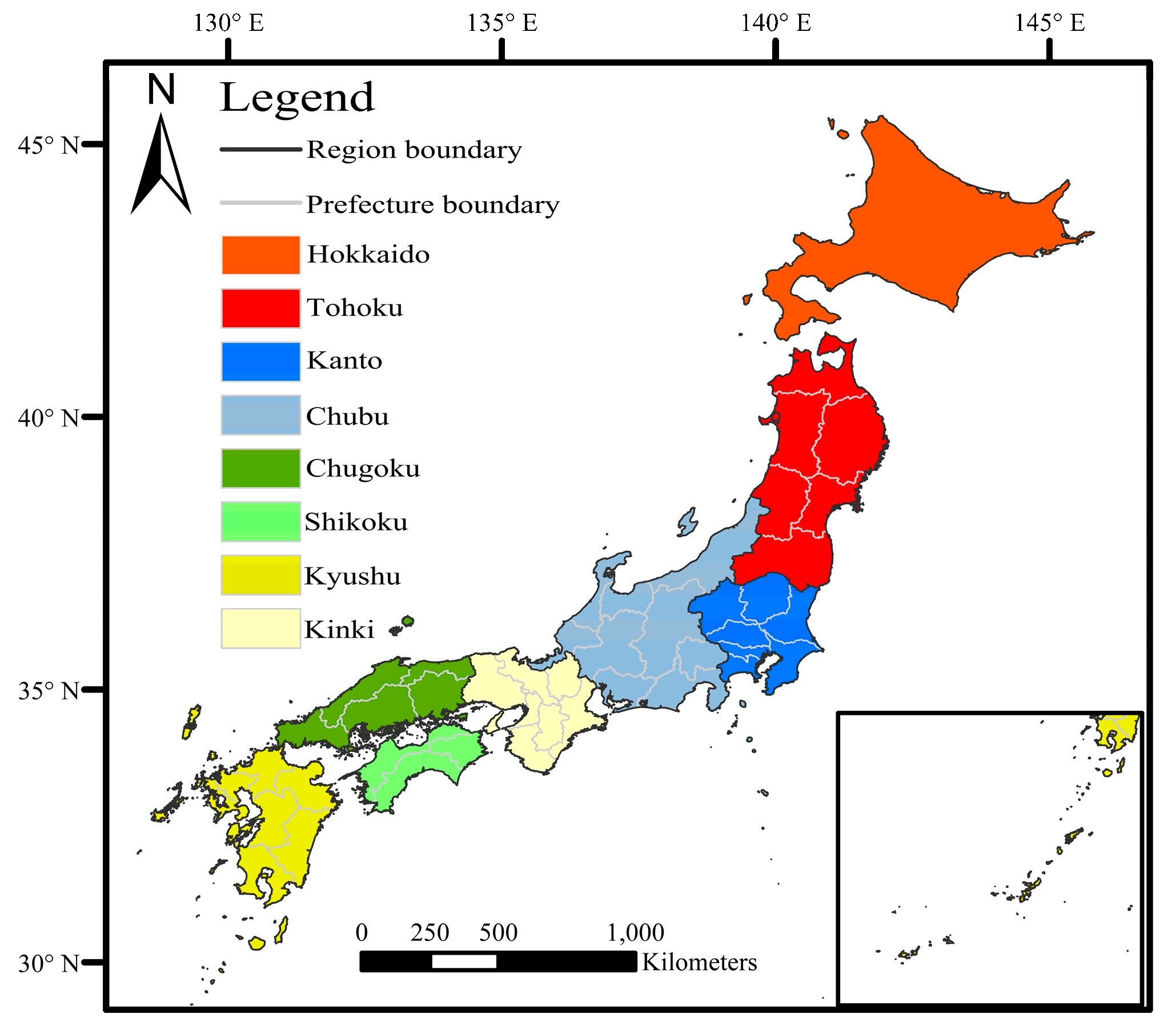
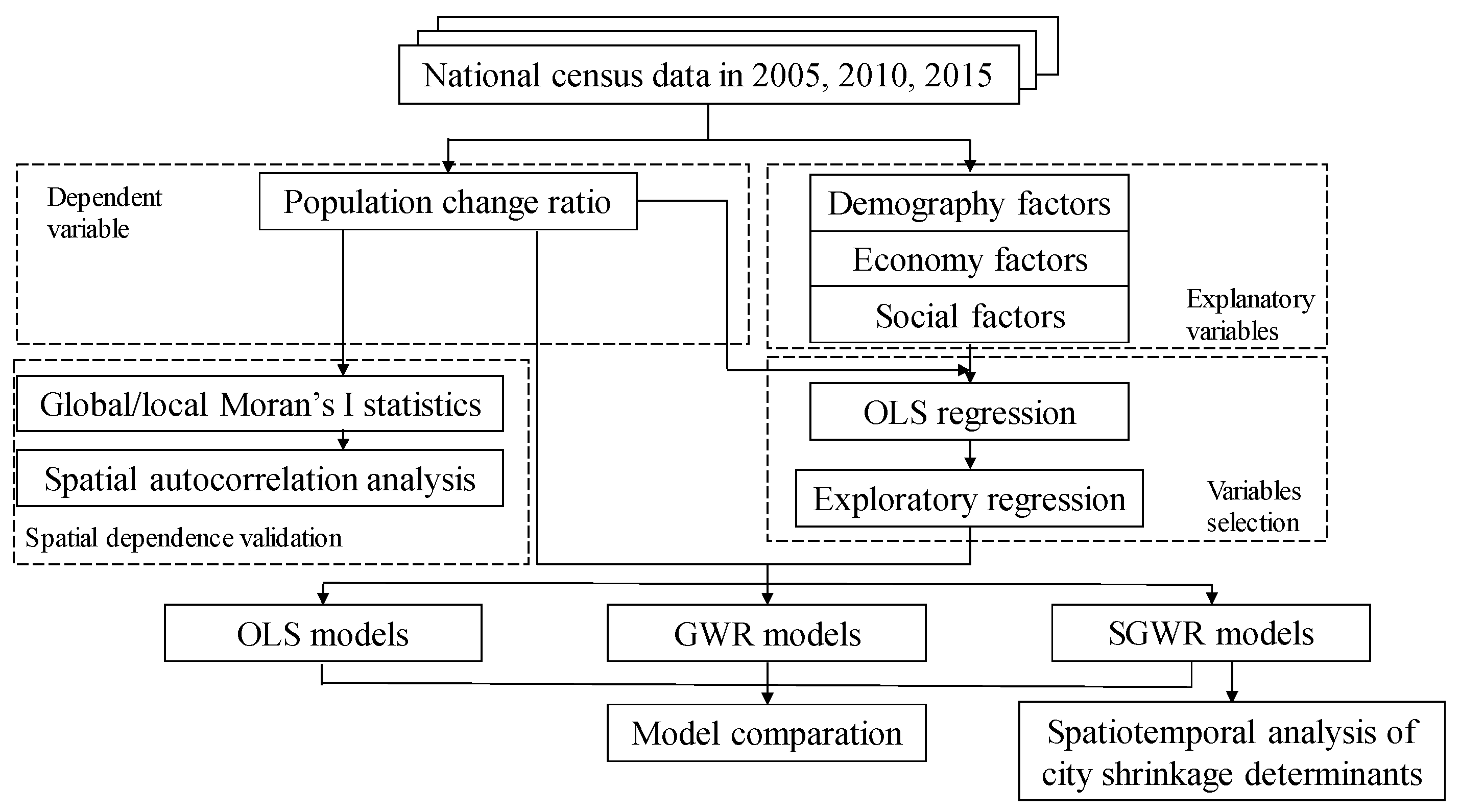
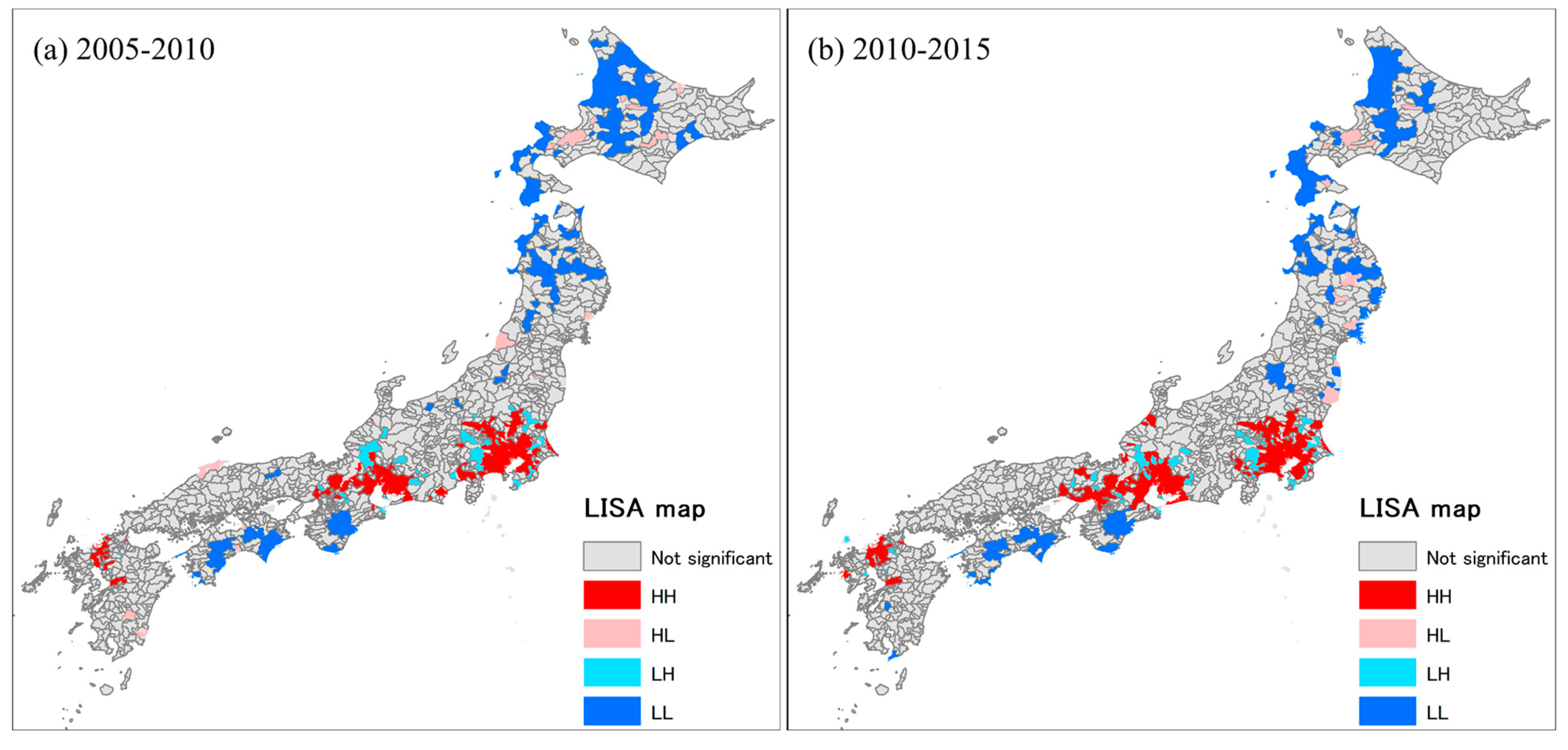
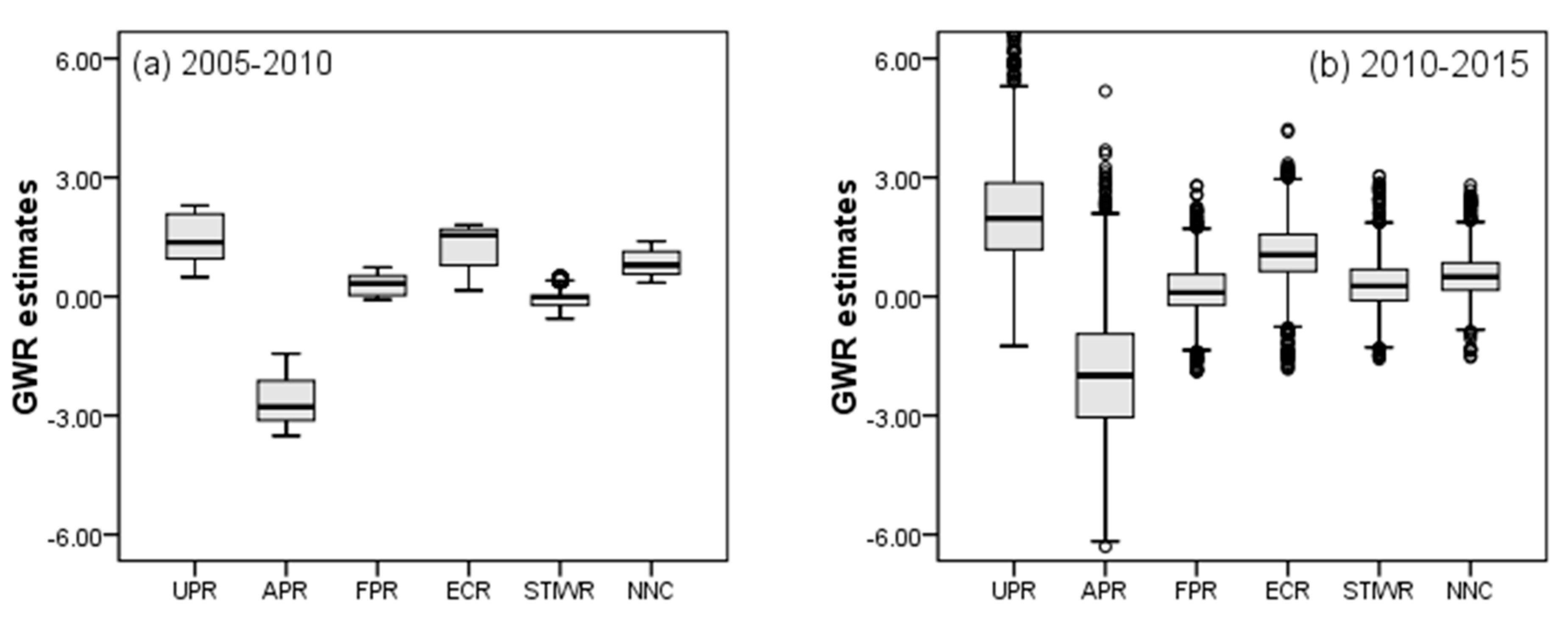
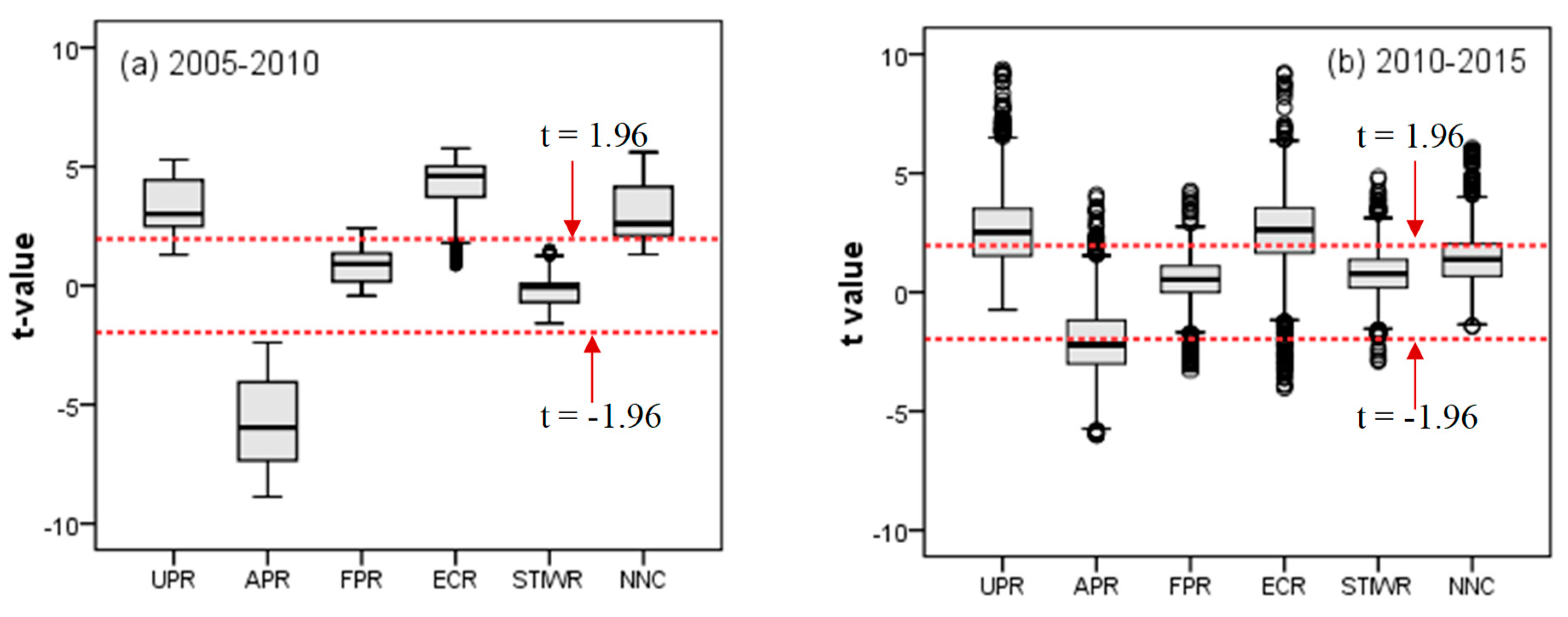
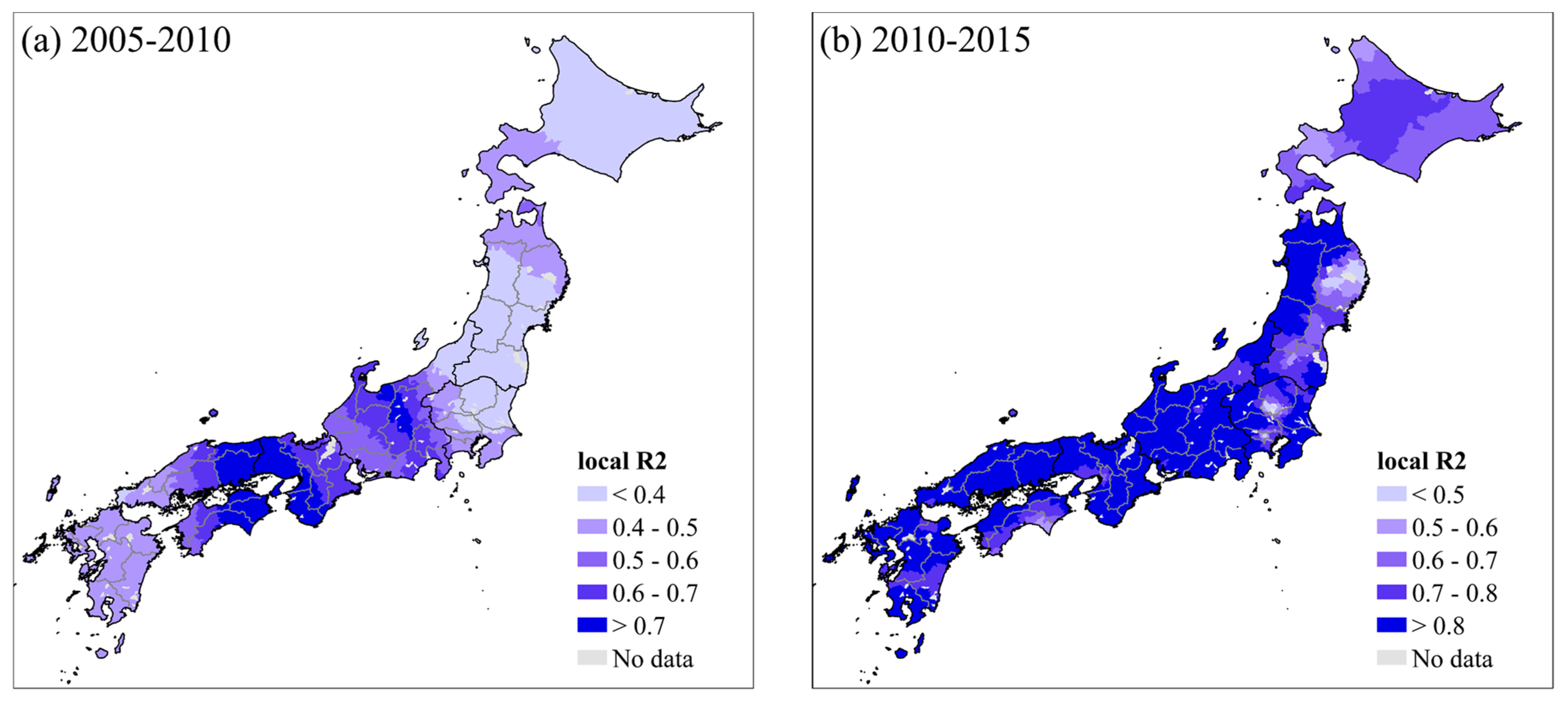
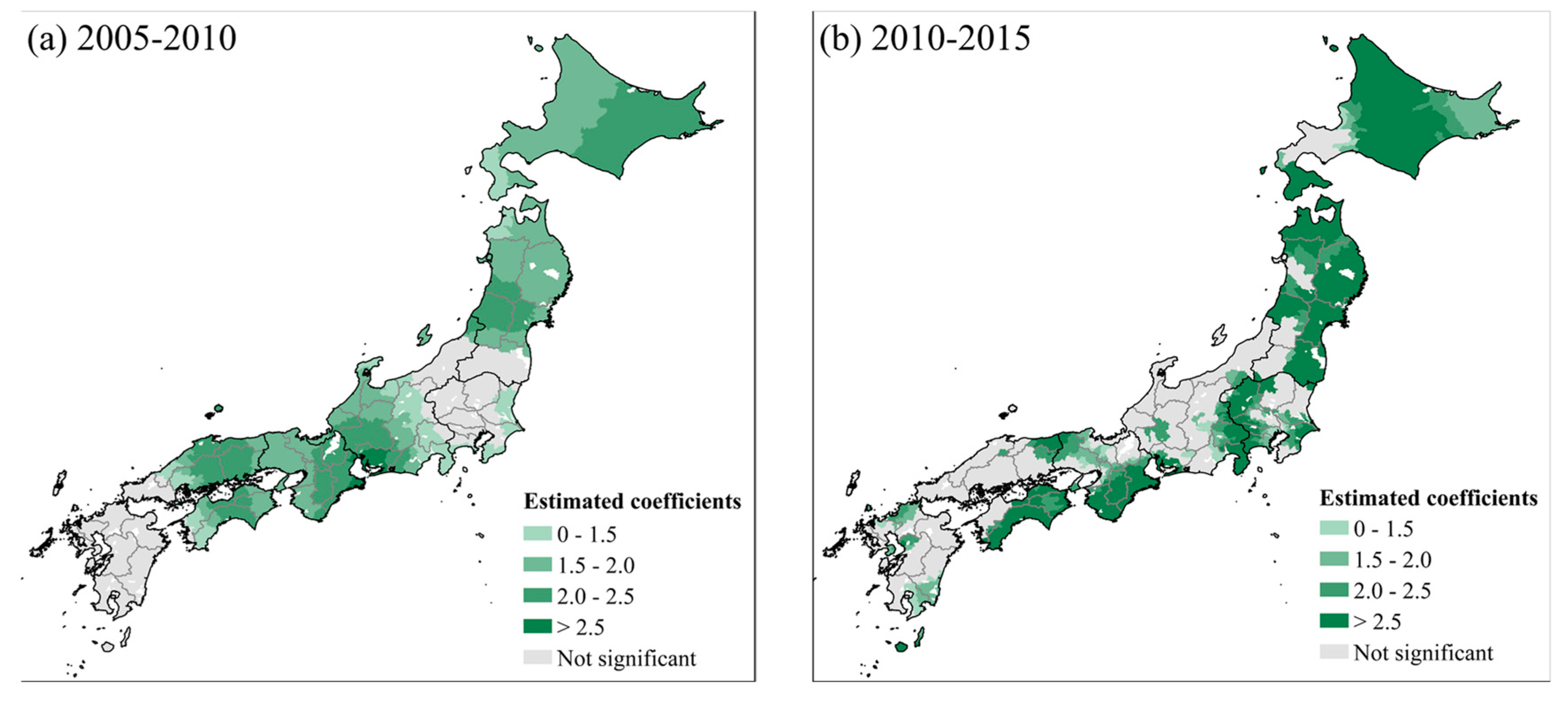
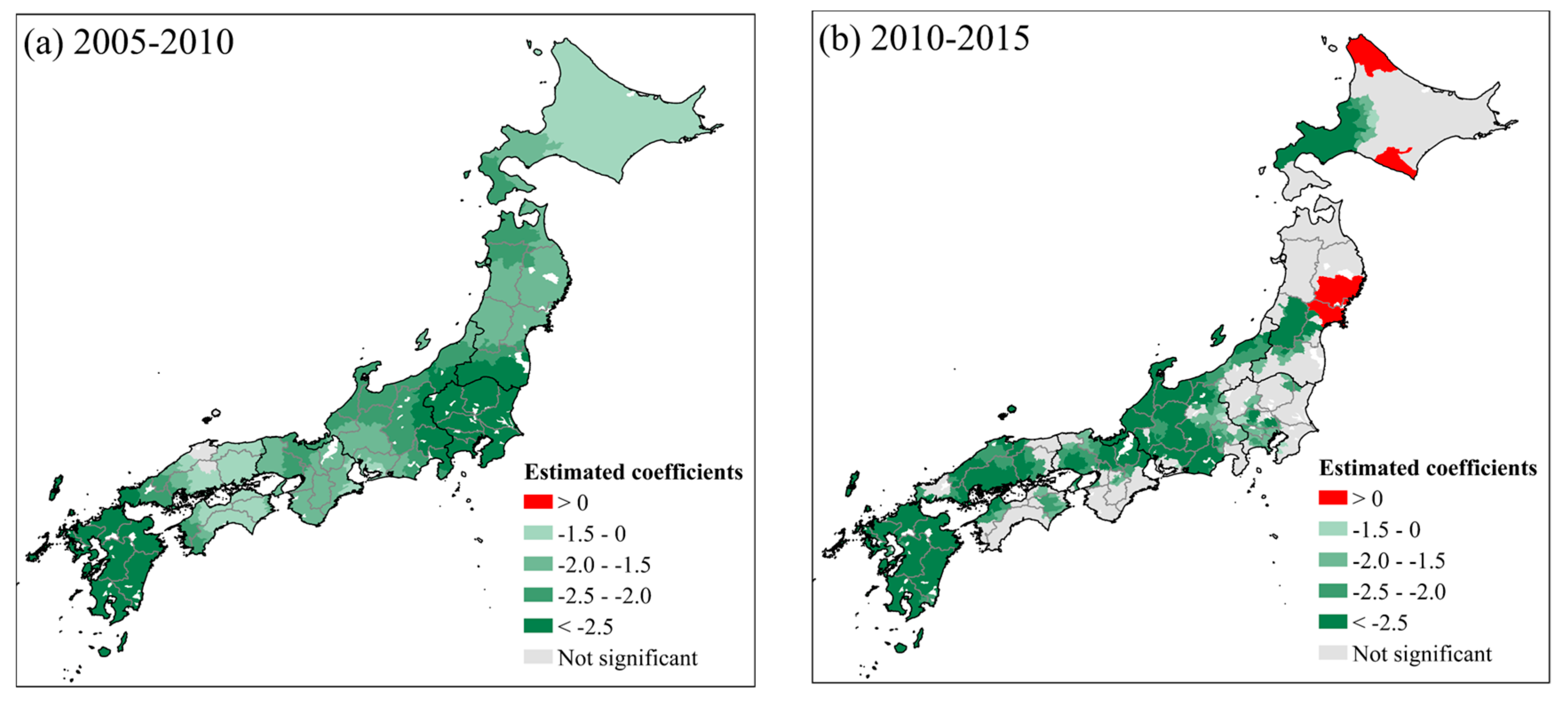
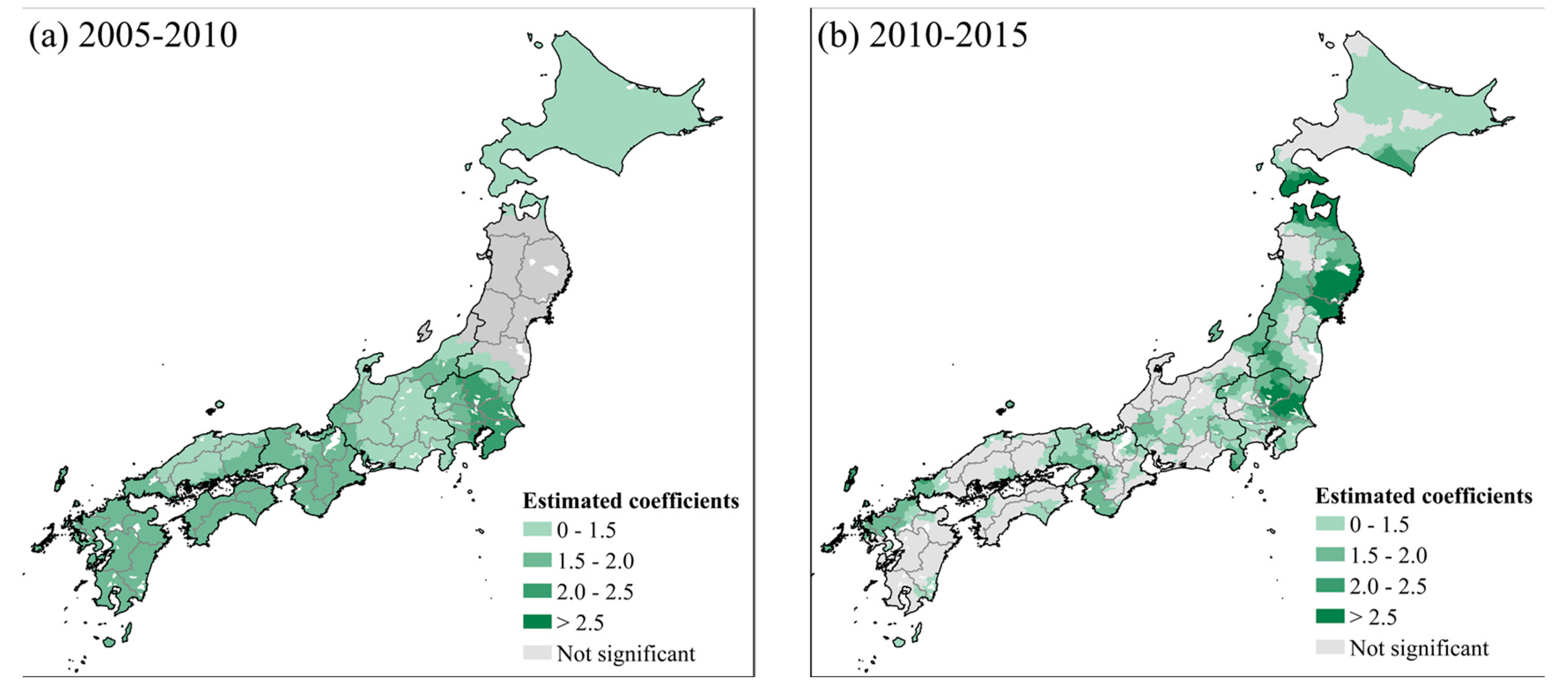
| Category | Description | Number |
|---|---|---|
| Large city | Population over 700,000 | 21 |
| Medium city | Population between 200,000 and 700,000 | 89 |
| Small city | Population below 200,000 | 631 |
| Town/village | Municipality type is town or village | 906 |
| Population Change | Municipality Level | |||
|---|---|---|---|---|
| Large City | Medium City | Small City | Town/Village | |
| Continuous shrinkage | 14.3% (3) | 27.0% (24) | 70.4% (444) | 80.8% (732) |
| Temporal shrinkage | 19.0% (4) | 28.1% (25) | 14.4% (91) | 10.9% (99) |
| Continuous increase | 66.7% (14) | 44.9% (40) | 15.2% (96) | 8.3% (75) |
| Population Change | Area | |||||||
|---|---|---|---|---|---|---|---|---|
| Hokkaido | Tohoku | Kanto | Chubu | Kinki | Chugoku | Shikoku | Kyushu | |
| Continuous | 89.4% | 88.2% | 52.0% | 66.0% | 68.4% | 82.1% | 90.2% | 75.0% |
| shrinkage | (160) | (194) | (146) | (225) | (134) | (87) | (83) | (174) |
| Temporal | 7.3% | 6.4% | 19.6% | 17.9% | 15.8% | 8.5% | 4.4% | 13.8% |
| shrinkage | (13) | (14) | (55) | (61) | (31) | (9) | (4) | (32) |
| Continuous | 3.4% | 5.5% | 28.5% | 16.1% | 15.8% | 9.4% | 5.4% | 11.2% |
| increase | (6) | (12) | (80) | (55) | (31) | (10) | (5) | (26) |
| Classification | Name | Description |
|---|---|---|
| Demographic indexes | TP | Total population (people) |
| UPR | Underage population ratio (age < 15 years) | |
| APR | Ageing population ratio (age ≥ 65 years) | |
| FPR | Foreign population ratio | |
| Economic indexes | CT | Per capita taxes (JPY/people) |
| GR | Government revenue (million JPY) | |
| ECR | Numbers of enterprise change ratio | |
| STIER | Secondary and tertiary industry enterprises ratio | |
| STIWR | Secondary and tertiary industry workers ratio | |
| UR | Unemployment rate | |
| Social indexes | SN | Number of primary and secondary schools |
| HN | Number of hospitals and clinics | |
| DN | Number of doctors (per 10,000 people) | |
| NEF | Number of elderly facilities | |
| NNC | Number of nursery centers |
| Study Period | Global Moran’s I | Z-Score | p-Value |
|---|---|---|---|
| 2005–2010 | 0.462 | 23.10 | <0.01 |
| 2010–2015 | 0.615 | 30.67 | <0.01 |
| Study Period | Intercept | UPR | APR | FPR | ECR | STIWR | NNC | R2 | Adjusted R2 | AICc |
|---|---|---|---|---|---|---|---|---|---|---|
| 2005–2010 | −3.556* | 1.262* | −2.907* | 0.315* | 1.029* | 0.040 | 0.855* | 0.525 | 0.512 | −5245.55 |
| 2010–2015 | −5.343* | 2.147* | −1.727* | 0.125 | 1.204* | 0.211* | 0.727* | 0.718 | 0.715 | −6761.06 |
| Study Period | Explanatory Variable | |||||
|---|---|---|---|---|---|---|
| UPR | APR | FPR | ECR | STIWR | NNC | |
| 2005–2010 | Local | Local | Global | Local | Global | Global |
| 2010–2015 | Local | Local | Global | Local | Global | Global |
| Parameter | 2005–2010 | 2010–2015 | ||||
|---|---|---|---|---|---|---|
| OLS | GWR | SGWR | OLS | GWR | SGWR | |
| Bandwidth | - | 341 | 201 | - | 87 | 66 |
| Residual squares | 395.17 | 373.21 | 369.09 | 157.46 | 80.94 | 77.27 |
| AICc | −5245.55 | −5282.90 | −5292.95 | −6761.06 | −7176.80 | −7288.49 |
| Adjusted R2 | 0.512 | 0.528 | 0.532 | 0.715 | 0.815 | 0.818 |
© 2019 by the authors. Licensee MDPI, Basel, Switzerland. This article is an open access article distributed under the terms and conditions of the Creative Commons Attribution (CC BY) license (http://creativecommons.org/licenses/by/4.0/).
Share and Cite
Peng, W.; Gao, W.; Yuan, X.; Wang, R.; Jiang, J. Spatiotemporal Differences in Determinants of City Shrinkage Based on Semiparametric Geographically Weighted Regression. Sustainability 2019, 11, 6891. https://doi.org/10.3390/su11246891
Peng W, Gao W, Yuan X, Wang R, Jiang J. Spatiotemporal Differences in Determinants of City Shrinkage Based on Semiparametric Geographically Weighted Regression. Sustainability. 2019; 11(24):6891. https://doi.org/10.3390/su11246891
Chicago/Turabian StylePeng, Wangchongyu, Weijun Gao, Xin Yuan, Rui Wang, and Jinming Jiang. 2019. "Spatiotemporal Differences in Determinants of City Shrinkage Based on Semiparametric Geographically Weighted Regression" Sustainability 11, no. 24: 6891. https://doi.org/10.3390/su11246891
APA StylePeng, W., Gao, W., Yuan, X., Wang, R., & Jiang, J. (2019). Spatiotemporal Differences in Determinants of City Shrinkage Based on Semiparametric Geographically Weighted Regression. Sustainability, 11(24), 6891. https://doi.org/10.3390/su11246891





